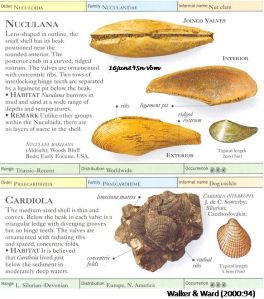[17-6-14Sl lab mikropal]
Koleksi fosil s/ hobi, after a while [bbrp waktu kmd], however, most collectors specialized in a particular group of fossils, such as trilobites, ammonites or plant fossils or perhaps an age or locality [p.22]
Initially, most collectors tend to regard fossils merely as objects that are attractive in their own right, a pleasure to admire & own [kenikmatan untuk mengagumi & memiliki]. With time & experience, the specimens themselves become less important & collectors soon realize that their true value lies in the scientific information they represent [kolektor segera menyadari bahwa nilai yang sebenarnya terletak pada informasi ilmiah yang mereka wakili]. Donating specimens to a local or national museum collection is one way a fossil collector can repay any help that he/she has received from museums rely very heavily on the generosity of amateur collectors [Menyumbangkan spesimen untuk menjd koleksi di museum lokal/nasional adalah salah satu cara seorang kolektor fosil dapat membayar kembali bantuan yang dia telah terima dari museum sangat bergantung pada kemurahan hati sang kolektor].
Seseorg yg hobi mengumpulkan fosil2 nantinya dia akan menjd seorg ahli PALEONTOLOGI (amatiran). Keahlian paleontolog amatir adl melihat s/ temuan yg unik yg kmd dia deskripsi. Jika dia menganggap bhw temuannya itu s/ yg baru maka dia akan publikasikannya di jurnal ilmiah. Temuannya itu kmd hrs disimpan di museum shg setiap org yg tertarik akan temuan tsb dpt melihat/mempelajarinya (public domain). This means that large vertebrate fossils are often placed out of the price range of most museums, and are, therefore, sadly, lost to the public [Ini berarti bahwa fosil vertebrata yg besar sering ditempatkan di atas kisaran harga & oleh karena itu, sayangnya, publik kalah]
#Bumi terbentuk pd 4.6 milyar th yl, sedang kehidupan baru muncul sekitar 3.85 milyar th yl. Organisma yg memp cangkang yg keras baru muncul pd 550jt th yl [p.14].
#Nama2 pd yg menyusun skala waktu geol adl nama2 lokasi temuan formasi sedimen yg mengandung s/ fosil
DIAPSID REPTILES [p.231]
#The second major division of the reptiles, the Diapsida, evolved during the Carboniferous, shortly after the evolution of the anapsid reptiles from the amphibians. Diapsid reptiles are characterized by the possession of two skull openings behind the eye sockets, but this condition is often obscured by modifications evolved to accommodate the various life styles of different species. Within the Diapsida are all modern forms, except turtles & the majority of extinct species. The group reached max diversity during the Mesozoic Era when its members -dinosaurs, various marine reptiles & pterosaurs -ruled land, sea & air
#Contoh: ichthyosaurus (early jurrassic) [p.238]; metriorhynchus (mid to late jurassic) [p.241]; diplocynodon (eocene – pliocene) [p.243]; pterodactylus (late jurassic) [p.244]
DINOSAURS [p.245]
#This successful diapsid group made up [merupakan] mainly of land-dwelling reptiles, first appeared about 225 mya, having evolved from the closely related thecodontian archosaurs. They are divided into 2 orders: the reptile-hipped Saurischia, in which the pubic bone face forwatds & the bird-hipped [burung berpinggul] Ornithischia, in which it faces backwards. Included in the Saurischia are the great four-footed herbivores & the two=-footed flesh-eaters, while the Ornithischia contains the remaining plant-eaters. The rise to dominance of the dinosaurs has been attributed to midifications of the limbs & girdle bones, which so improved their stance [cara berdiri] & gait [cara berjln] that they were able to adapt to new habitas. Their largely unexplained extinction at the end of the Mesozoic Era, along w/ most of the gerat aquatic reptiles, brought to an end 150my of domination
#Contoh:
@@@@@@@@@@@@@@@@@@@@@@@@@@@@@@@@@@@@@@@@@@@@@@@@






